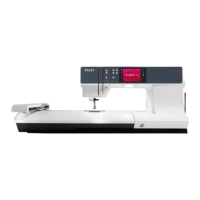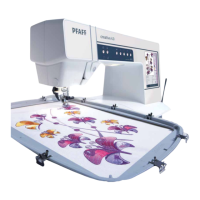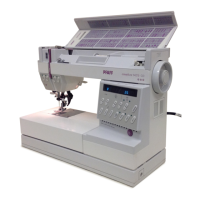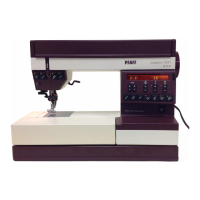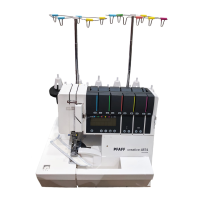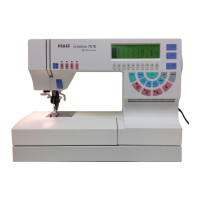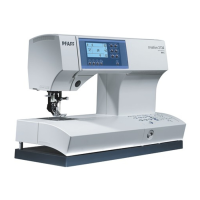What to do if my Pfaff Creative Vision fabric does not move?
- TTony FinleySep 12, 2025
If the fabric isn't moving, ensure that the machine isn't set to free-motion mode in the Settings menu.
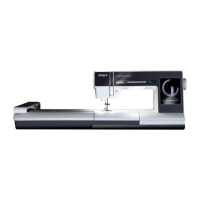
What to do if my Pfaff Creative Vision fabric does not move?
If the fabric isn't moving, ensure that the machine isn't set to free-motion mode in the Settings menu.
Why is the needle thread breaking on my Pfaff Sewing Machine?
Needle thread breakage can occur due to several reasons: * Ensure the needle is correctly inserted. * Verify you're using the correct needle system 130/705 H. * Replace the needle if it's bent or blunt. * Double-check that the machine is threaded properly. * Ensure the needle size is appropriate for the thread. * If you're using poor quality, old, or slubbed thread, switch to a new, high-quality thread.
What to do if my Pfaff Creative Vision won't sew?
If your Pfaff Sewing Machine isn't sewing, check these items: ensure all plugs are securely connected to both the machine and the wall socket. Also, make sure to push the bobbin winder lever to the sewing position.
Why is the seam on my Pfaff Creative Vision has uneven stitches?
Uneven stitches in your seam can be caused by several factors: * Verify that the thread tension is correct and the machine is threaded properly. * If you're using thread that is too thick or slubbed, change the thread. * Check the bobbin winding to ensure it's even. * Make sure you're using the correct needle, inserting it properly.
Why is the bobbin thread breaking on my Pfaff Creative Vision Sewing Machine?
If the bobbin thread is breaking, consider the following: * Check that the bobbin is inserted properly. * Inspect the stitch plate for damage and replace if necessary. * Clean any lint from the bobbin area and use only the original PFAFF® bobbins approved for this model. * Ensure the bobbin is wound correctly; wind a new one if needed.
Why is my Pfaff Creative Vision Sewing Machine not feeding fabric properly?
If your machine isn't feeding fabric correctly or is feeding irregularly, check that the machine is threaded properly. Also, remove the stitch plate and clean the feed dogs with a brush to remove any collected lint.
What to do if my Pfaff Sewing Machine screen and/or function buttons do not respond to touch?
The sockets and function buttons can be sensitive to static electricity. If the screen doesn't respond to touch, turn the machine OFF and then ON again. If the problem persists, contact your authorized PFAFF® dealer.
What to do if my Pfaff Creative Vision Sewing Machine embroidery design has puckered?
If the embroidery design has puckered, ensure you are using the proper stabilizer for your technique or fabric type.
What to do if my Pfaff Creative Vision is not cutting the thread?
If the thread snips aren't cutting the thread, remove the stitch plate and clean lint from the bobbin area. Also, enable automatic thread snips in the Settings menu.
What to do if my Pfaff Creative Vision Sewing Machine screen is turned off?
If the PFAFF® HD screen is turned off, touch the screen to activate it. Also, turn off the screen saver in the Settings menu.
| Sewing Speed | 1000 stitches per minute |
|---|---|
| Display | Color Touch Screen |
| USB Connectivity | Yes |
| Screen | Color Touch Screen |
| Needle Threader | Automatic |
| Bobbin Winding | Automatic |
| Automatic Thread Cutter | Yes |
| Embroidery Area | 360mm x 200mm |
| Stitch Length | 6mm |
| Stitch Width | 9mm |
Key safety guidelines for operating the sewing machine, covering electrical hazards and personal injury prevention.
Guidelines for the maintenance and repair of double-insulated sewing machines.
Detailed description of the sewing machine's front, rear, and top parts.
List and identification of accessories provided with the sewing machine.
Catalog of utility stitches, decorative stitches, and alphabets available on the machine.
Steps for unpacking, connecting power, and initial setup of the machine.
Guidance on threading the machine, winding and inserting bobbins.
Details on spool pins, IDT, knee-lift, needles, presser feet, and USB ports.
Overview of the HD screen, task bar, common icons, and touch functions for interaction.
How to use the selection menu to access stitches, fonts, and designs.
Adjusting size, shape, position, and rotation of embroidery designs.
Introduction to selecting, adjusting, and sewing stitches in sewing mode.
How to select stitches and adjust parameters like width, length, and density.
Using sewing programs like tapering, patchwork, and special techniques.
Introduction to creating and adjusting sequences of stitches.
Details on inserting, duplicating, deleting, and mirroring stitches in a sequence.
Using tie-offs, stops, thread snips, and horizontal preview in sequences.
Guide to creating custom stitches using the on-screen editor and its tools.
How to edit individual stitch points, including mirroring and duplication.
Using zoom, multi-select, and touch functions for stitch editing.
Overview of the embroidery unit, its components, and the embroidery hoops.
Steps to connect and disconnect the embroidery unit from the machine.
How to correctly hoop fabric and position designs for embroidery.
Introduction to the edit mode and how to load designs, fonts, and stitches.
Using zoom, multi-select, delete, group, and mirroring to edit designs.
Using move, rotate, scale, and pan functions for design adjustments.
Overview of the stitch-out mode, including crosshairs, color lists, and stitch progress.
Details on thread tension, basting, color block sorting, and pan function.
Using hoop position functions and precise positioning for accurate embroidery.
Introduction to organizing, adding, moving, and removing files and folders.
List of supported file formats for embroidery and stitch files.
How to create, rename, move, copy, and delete files and folders.
Instructions for cleaning the machine, bobbin area, and replacing the stitch plate.
Solutions for problems related to stitches, thread breaks, fabric movement, and embroidery.

